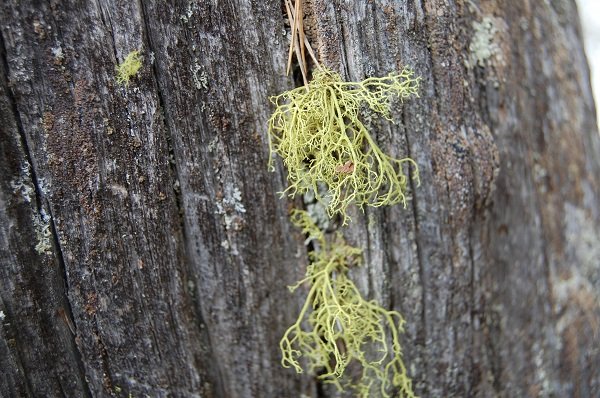Wolf lichen (Letharia vulpina); the lichen that was used to kill predators!
During one of my latest trips, I came across the wolf lichen (Letharia vulpina). This is a very interesting lichen with a lot of history, seeing as it was used to kill predators such as wolves, foxes and whatever else would eat the farm animals. The lichen has a bright green-yellow color, and grows strictly on dead trees, preferably dead pine. However, if the tree trunk falls to the ground, the humidity gets too high, to you mainly find it on dead pine trees that are still standing. It is very easy to spot, because the colors are not really typical for lichens, so you can see it from a distance.

L. vulpina. Image by @valth, taken in April 2017 in Trillemarka nature reserve in Norway.
The process of using this lichen to kill predators was simple: grind it into a powder and mix it in with a lot of meat. The farmers in Norway apparently used reindeer or moose. Some farmers would also add some glass pieces into the meat to make sure the powder would enter the blood stream of the animal. This bait was put somewhere close to the farm animals to lure the predator into eating it, and it would die without the farmer having to hunt it.
What is really cool is that the poison in the wolf lichen, called vulpinic acid, seems to only be dangerous for predator species, and herbivores can eat it without getting sick and die. I tried to find more information about why this is, but it would seem that no one really knows for sure. Maybe a future study can shed light on this sometime in the future?
Poisoning animals are mostly outlawed in modern society, but I still find it really interesting that this lichen has such a unique use. The latin name Letharia vulpina translate roughly into something like “deadly for foxes”, so it seems the use was known before it got identified by scientists.
In Norway, the wolf lichen is considered VU – vulnerable by the National Red List, mainly due to its habitat loss. Because of logging, most pine trees are logged a long time before they get to die naturally, so we don’t really have that much old-growth forest left. This makes it difficult for the wolf lichen to find a suitable tree, so it is really rare to find these days.
The wolf lichen is however not on the international red list, so it might not be all that rare in the US and in the rest of the Europe.
About the author
Hi, I’m @valth! I live in Norway with my girlfriend, our newborn son, and our two dogs, one of which is seen wearing a bow tie in the profile picture!
I am very passionate about nature and biology, and have been studying ecology for a few years now. My passions are mostly within conservation biology, mycology (the studies of mushrooms), animal behavior and general microbiology. I really enjoy both the theoretical aspect, as well as the more practical aspect of biology, and I spend about as much time in front of biology textbooks as I do spend on finding and identifying plant, mushroom and animal species in the forests.
Make sure to hit the big follow button above to go to my profile and follow me! This will make sure all of my posts end up right in your feed, and you can get your daily dose of biology news without any hassle :)

Hi @valth, very interesting post, today you learned me something interesting, thank you.
Thanks reading and commenting! I'm glad you liked it :D
You are welcome.